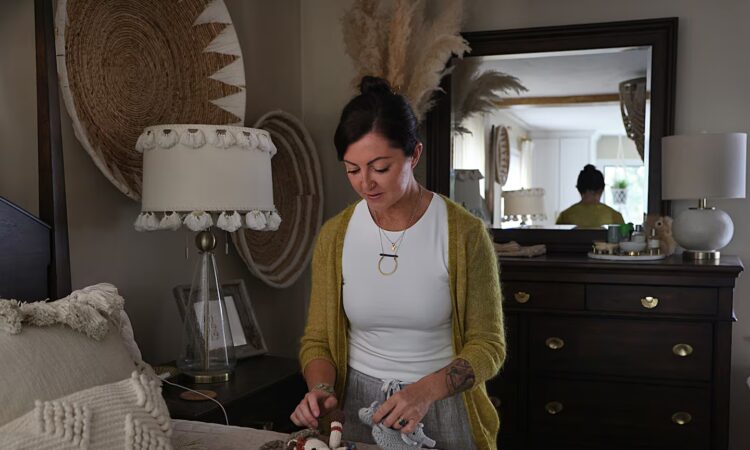
The care was supposed to be just as good, and the prices were far cheaper. Torres started IVF in Tanzania, and then did Facetime consultations with clinics in the Czech Republic, North Cyprus, and Spain. She finally chose Greece, a place growing as popular for fertility medical tourism as Tijuana, Mexico, is for dental work and Turkey is for hair transplants.

Talking to a friend in Florida only underscored Torres’s confidence in her decision. In that state, which doesn’t have a mandate for IVF insurance coverage, her friend’s entire IVF cycle cost more than $24,000, including $6,800 for medication. In Greece, Torres would spend just $10,000, including the hotel, travel, IVF procedures, and meds. Only $1,532 of that total was for drugs.
Not everyone’s work or life is flexible enough to allow them to fly to Greece twice in a month. Torres knows she is lucky, but she wants more people to know it’s possible to travel to another country and do IVF for a fraction of the price.
“Why it is so expensive [in the US] is beyond me,” said Torres, 41. “It’s crazy it’s gotten this out of control. And it’s sad. We want to be home. We wanted to be home a year ago. But with the cost of everything with IVF, it’s impossible.”
The Massachusetts mandate requiring that insurers cover infertility treatments was once considered the nation’s strongest. Yet gaps in the law mean that more than one in four women in the state don’t have coverage, a Globe analysis found. And even those who have insurance often incur significant out-of-pocket expenses.

The procedure’s punishing price tag, even for many with insurance, has led thousands of patients to try money-saving hacks. Some, like Torres, undergo the entire process overseas. Others just purchase drugs from international pharmacies, using companies that have sprung up to meet demand. Many turn to strangers to share leftover medications.
They meet up in parking lots or drive to one another’s houses or ship medications across the country. Some worry what they are doing is illegal, but many are past the point of caring – they do whatever they can to help others, or themselves, deal with the expense and isolation of infertility.
“It’s kind of like (the first rule of) Fight Club,” said Kelly Clinton, a Salem mother who used IVF for her child and helps run a Facebook group on the topic. “They don’t outwardly mention it. But if you are in a support group, you know it’s an option. … That’s probably the No. 1 dirty little secret of IVF, is the med sharing.”
A number of factors conspire to make fertility drugs prohibitively expensive. A modest market size coupled with an expensive regulatory process has stifled innovation. It can typically take years for new drugs — even ones already approved in Europe and elsewhere — to enter the US market.
President Trump announced last week that the major fertility drug manufacturer EMD Serono, which has a US headquarters in Boston, would reduce the price of its portfolio of fertility drugs by up to 84 percent for eligible patients. His administration also said it would speed up the regulatory process for other meds.

It’s still unclear how the changes will play out.
But medication costs are only part of the problem. A wave of fertility clinic acquisitions by private equity firms has also turbocharged the profit imperative in the field, and limited regulations mean few guardrails.
“They have people by the balls,” said Alexander Borsa, a PhD candidate at Columbia University and member of the GenderSci Lab, which looks at sex and gender in biomedical research. “It’s understood patients are extremely emotionally vulnerable. There is a tacit understanding that things will be expensive. If someone tells you you need to do something to have a baby, you will find a way to do it.”
Like many women before her, Torres found a solution.
In late June, she was navigating the narrow, cobblestoned streets of the Plaka neighborhood in Athens, a green-apple frozen yogurt in hand. Bougainvillea spilled over ancient buildings. Vendors hawked trinkets and fruit.
The worry and waiting of the egg-retrieval process melted away amid such beauty. She kept forgetting why she had come, only for the real reason to flash back.
I can’t believe I’m here for IVF, she thought.
In the most expensive classes of IVF drugs, there hasn’t been innovation in 20 years. Evan Sussman is trying to change that.
He co-founded his Duxbury-based company, Granata Bio, to bring products to market, some to compete with high-cost medicines. But developing fertility drugs for the US market is no easy feat.

In the 2000s, the Food and Drug Administration tightened its process for approving fertility drugs. Instead of requiring companies to prove a medicine increased the number of mature eggs, for instance, drug makers had to prove they had achieved the end goal of infertility treatments — a live birth.
There are hundreds of variables that factor into the birth of a baby, any one of which could affect the outcome. So the clinical studies for new treatments must be massive, involving thousands of patients and costing over a hundred million dollars.
The market for fertility drugs is small compared to, say, drugs for cancer ($87 billion in the US in 2023) or weight loss ($2.7 billion). The whole US market for a fertility drug might be only $400 million to $500 million, said David Stern, an industry expert.
“If you are going to spend $100 million to get a drug approved, what is your payback time? What market share will you get?” Stern, who is now CEO of Kindbody, a New-York based company that offers fertility benefits, asked rhetorically. “You will be at a loss for a long period of time before you start even making profit.”
Such challenges have allowed existing products, from companies with global reach, to dominate the market. In the United States, for example, there is only one human menopausal gonadotropin, or hMG, available to patients: Menopur.
Gonadotropins are key for IVF, stimulating the ovaries to produce more eggs and giving clinicians the best odds of creating a healthy embryo. Menopur is used in approximately 85 percent of IVF cycles, Sussman said.
Swiss-owned Ferring Pharmaceuticals reported more than $1 billion in 2024 revenue from global sales of Menopur.

The Washington Post/The Washington Post via Getty Images
“There has essentially been a monopoly created,” Stern said. “It’s actually the FDA that makes it very difficult to come up with a new product or biosimilar.”
Trump’s recent announcement may hasten the arrival of a competitor. He promised an expedited review for EMD Serono for its drug Pergoveris, which was approved and launched in Europe in 2013. It is unclear what kind of data the FDA will require, but the approval process could bring to market a competitor to Menopur much more quickly.
As part of that deal, Trump said, EMD Serono would offer direct sales of its portfolio of IVF drugs to eligible patients, which could result in savings of up to 84 percent.
“It’s very positive, the steps the White House has taken to reduce the cost of fertility drugs, which has an impact on the overall cost of fertility treatment in the US,” Stern said. “It will significantly reduce the cost.”
Others were more skeptical. Davina Fankhauser, executive director of the advocacy group Fertility Within Reach, said medications are only part of the expense for an IVF cycle, and discount programs were already available based on financial need.
“If you can’t afford $10,000 for an IVF cycle, savings on medication won’t be the determining factor that allows you to move forward with treatment,” she said.
In many other countries, especially those with socialized medicine, the government has more sway over drug prices, reducing the need for creative bargains like the one Trump has proposed with EMD Serono.
Regulatory hurdles are also lower overseas, where the endpoint for clinical trials isn’t a live birth, but proof the drug does what it says. In Europe, Menopur has at least one competitor – which Stern said has helped drive down costs.
Patients have subsequently turned to markets overseas to access cheaper drugs. It is technically illegal to import drugs from international pharmacies, even when the drug has been approved in the United States. However Sara Shikhman, a health care lawyer with New York firm Lengea Law, said the rules are not strictly enforced, and the FDA permits some individuals to import drugs for personal use.
Patients are increasingly availing themselves of that option, using companies that have sprung up abroad largely to ship cheaper drugs to Americans. A round of 20 vials of Menopur typically costs around $5,000 here, according to GoodRx, but the Israeli infertility company IVFPharmacy charges just $760. In Reddit forums, American patients describe saving big by buying abroad.
Shikhman herself looked into these options when going through her own IVF process.
“You’d think, I’m a lawyer who runs a law firm, and should be able to afford something like IVF. But if I’m being asked to pay, just for meds, $5,000 … that’s a crazy price,” she said.
Doctors say many patients who lack fertility coverage or have already exceeded their insurance maximums explore traveling abroad to buy drugs.
“Not infrequently, we will have patients go to Mexico, Canada … go overseas where their parents live to get these medications,” said Dr. Pietro Bortoletto, a reproductive endocrinologist who recently co-founded his own clinic, Terra Fertility. “The vast majority of people are using infertility coverage. But once you have run that dry and want to keep going, you have to figure out what’s the thing to shave some dollars off.”

Suzanne Kreiter/Globe Staff
While some look abroad, others quietly – and anonymously as possible – look for swaps locally. One woman, who worked for a prominent fertility benefits company, discovered her fertility benefit was capped at $15,000. While she was grateful she had some benefits, they would be only be enough to pay for the clinic costs. For medication, she turned to women in Facebook groups.
“I’ve told countless people afraid of going this route, ‘I can help you,’” she said. “I think this is something [where] there should be regulations, but we’re being failed by the system. You figure it out on your own in another way.”
A woman from Andover had robust coverage from an out-of-state insurer for three rounds of IVF. But she only had enough medication coverage for part of one cycle. She subsequently drove up to a house in Medford and grabbed a box of meds at the front door. Another time she met a woman at the Tanger Outlets in New Hampshire. She bought an orchid for a woman in Worcester who provided thousands of dollars of additional medication.
For cheaper drugs, she would pay out of pocket. But for drugs like Menopur, she turned to Facebook.
“I called around, probably half a dozen different pharmacies,” she said. “I tried my best. Some won’t give you quotes over the phone. They have to wait for your doc to send the prescription there and then they’ll quote you. … I spent hours one day to price compare, [only] to discover the donation sites. I’m grateful, very grateful for them, and all the women helping each other. I wouldn’t have been able to do it without them.”
She ultimately bought more coverage through the state’s health insurance market to do another three rounds of IVF. She is now pregnant.
Sussman, the Duxbury entrepreneur, knows there is a US market for a competitor to Menopur. Granata’s product is finally in the late stage of clinical trials. But the company has been working to bring its drug to market for five years. He estimates he has at least three more to go.
The company is working on bringing other drugs to market as well. It is developing a new form of progesterone. Granata additionally has a drug, based on technology developed at and licensed out by Massachusetts General Hospital, that protects ovarian reserve and has potential applications in contraception, menopause, and IVF.
“Drug development is a slog — long, arduous, and expensive,” Sussman said. “I love what we do, but you can see people deflate when you say when will this get to market. My kid could have entered and graduated college.”
Clinics consolidate; costs rise
The astronomical cost of medication only partly explains why a single IVF cycle in Massachusetts can cost up to $25,000, which may or may not be covered by insurance, according to the organization Fertility Share. There are many other drivers. Reproductive endocrinologists and embryologists don’t come cheap. The same goes for the lab equipment and technology to freeze, store, thaw, analyze, and fertilize reproductive cells.
David Sable, a former OBGYN and IVF doctor who now manages a reproductive medicine venture portfolio, said the prices simply reflect supply and demand.
“The industry in aggregate maxes out at a price point that is a balance of how much can we charge for it, versus how much can large groups of people afford to pay for it,” Sable explained. “There is no conspiracy to keep the price high. But it’s a kind of equilibrium the industry finds itself in.”
Yet the mere presence of venture capital and private equity firms in the infertility market suggests investors are smelling a profit. And the downstream effect of the profit imperative on patients can be painful.
Christine Hochkeppel and her wife had been storing donated sperm at Fenway Health, a nonprofit specializing in care for LGBTQ patients, where they had done intra-uterine insemination, in which sperm is placed into the uterus by a clinician. When they needed IVF, they had to seek care at a fertility clinic. But when they shipped the leftover sperm to Boston IVF, a for-profit clinic, their storage costs jumped from $200 to $1,200 a year.

In a statement, Boston IVF defended its sperm-storage costs, saying they are a function of the location and scale of their business. “We believe our rates are at or below market average for on-site storage,” a spokesperson for the clinic said in a statement.
However, at Terra Fertility, the recently opened physician-owned clinic, sperm storage only costs $60 a month, or $720 a year.
During the lengthy and expensive process to retrieve eggs and create embryos, Hochkeppel said, Boston IVF strongly recommended the couple pay another sizable bill, this one for pre-implantation genetic testing.
Genetic factors are a main cause of early miscarriage, and such tests purport to decrease their odds. Some studies have shown the most common test, called PGT-A, increased live birth rates in older women. However, professional groups have contested studies with positive findings. Other studies have shown either no benefit to such tests or found they have a high false positive rate – meaning embryos initially deemed to be abnormal were actually fine. Many insurers still classify the technology as experimental and don’t cover it.
That hasn’t stopped clinics from offering PGT-A testing. According to complaints filed by Constable Law, a Florida firm that has filed lawsuits alleging false and misleading marketing for the tests, their use has roughly tripled in less than a decade. By 2021, they were used in 40 percent of IVF cycles. In all, PGT-A testing generates as much as $400 million in annual revenue.
Hochkeppel and her wife ultimately opted for PGT-A testing, even though her insurance wouldn’t cover it. The $4,000 test narrowed the number of embryos deemed viable from four to one. Hochkeppel had wanted to implant that one, but her doctor recommended banking more embryos first, given that she was already 40 and more embryos would improve her odds of getting pregnant. But that recommendation would come with even more headaches, and more costs — including more sperm.
Another woman, who spoke on the condition of anonymity, had tried repeatedly to get pregnant through IUI and IVF, but after spending thousands of dollars, hadn’t had success. She and her husband found a couple online willing to donate embryos.

Going that route has risks. The couples signed a contract and paid a lawyer to oversee it, but even the attorneys said the deal was in uncharted waters. When the woman went to discuss shipping the embryos to her Massachusetts clinic, private equity-backed CCRM, it said no. The clinic told her they couldn’t be sure of the embryos’ quality.
“They make a lot of money off their donor egg program,” she said. “And all they would get off this is the frozen embryo transfer fee, which is like $2,400 — instead of $20,000 off donor eggs. It makes me question if they want to do what’s best for the patient versus what’s best for their wallet.”
The woman decided against moving the embryos and will instead travel to the clinic where they are stored.
“We want a family. Period,” she said, tearing up. “We will get there one way or another.”
In a prepared statement, CCRM said its mission is to ensure patients receive high-quality, individualized care.
“The clinical and lab standards employed by CCRM’s affiliated providers as part of a patient’s care are solely focused on this goal,” the company said.
If fertility clinics are already expensive, private equity’s increasing stake in the business may send prices further skyward. But tracking that trajectory will be hard, said Borsa, the researcher from Columbia.
“The fact that the costs in fertility are so high and unregulated is one of the reasons why it was attractive to PE,” Borsa said. “In fertility specifically, it was looked at as this deeply unregulated industry. … Desperate people show up crying on your doorstep and will pay whatever you tell them.”
In 2018, IVF was described as the medical sector most dominated by private equity, with PE-owned clinics performing nearly a third of all cycles of assisted reproductive technology nationwide. In the years since, PE’s outsize share has only grown, according to data collected by Pitchbook.
Massachusetts reflects that trend. In 2022, there were eight companies operating fertility clinics in the state, two of them owned by private equity. As of September, there were seven, three owned by private equity.

Private equity involvement has boosted prices elsewhere. One 2019 study observed that consolidation in the Australia/New Zealand fertility market, spurred by private equity, meant that three IVF companies controlled 80 percent of IVF cycles. The Sydney Morning Herald noted that at one Melbourne clinic, the cost of an embryo transfer rose an average of 13 percent annually from 2007 to 2012, though patients reported that nothing about the experience had changed.
Even if prices for specific procedures remained the same, private equity firms are likely to push more add-on services, researchers say. Research has shown that there were 10 percent more patients using any type of pre-implantation genetic testing at PE-affiliated practices.
“More genetic testing may be helpful but could be of low value or unnecessary,” said Zirui Song, an associate professor of health care policy and medicine at Harvard Medical School. “Is this spending clinically necessary, and indicated, or unnecessary but a source of additional revenue?”
Hochkeppel wondered the same thing as she ponied up approximately $4,000 for PGT-A testing yet again after her third egg retrieval.
This time, the test raised questions about all four embryos. One came back abnormal, while two showed two X chromosomes and one Y, which can cause fertility issues in boys. The fourth embryo had to be biopsied a second time, which could decrease its viability, until the results came back normal.

“It’s really frustrating,” Hochkeppel said. “It makes you wonder, why are they selling this test that basically has just eliminated a lot of my embryos? If they are in the business of making money, it makes sense to eliminate as many embryos as they can to keep you coming back and paying more and get more from the insurance. It starts to shake your faith in the process, that it doesn’t seem a reliable test.”
Boston IVF defended its use of PGT-A testing and said it does not require or recommend it for all patients. But a spokesman listed “significant benefits” from such tests, including higher pregnancy rates and lower miscarriage rates.
Boston IVF has since been acquired by a private equity-backed firm, one whose clinics require patients to freeze all embryos – which in turn is generally associated with higher prices.
The firm’s spokesperson said Boston IVF does not have such a policy now but noted that such policies can produce “higher pregnancy rates and fewer complications.”
Sable, the IVF fund manager, said in his personal experience doctors are trying to help patients, not talk them into unnecessary tests.
Still, private equity firms have a reputation for a relentless focus on profit. A person who works at a PE-backed fertility company – and has knowledge of the company’s finances – said the top goal of the firm’s clinics is to increase new patient visits and new cycles to drive revenue. The company closely monitors whether clinics are meeting their targets.
“I can’t imagine a PE firm that will come in and be more focused on the mission than the profit,” said the employee, who spoke on the condition of anonymity, as they were not authorized to speak on behalf of the company. “I don’t think those exist.”
Back at home in Sagamore Beach in August, Torres held knitted baby slippers. There wasn’t yet a baby to wear them, but there was still a lot of hope.
Torres had completed her Greece trip a few months before and reveled in the memories of it. For two weeks, she had gone into the clinic for local monitoring, indulged in fresh Mediterranean food, had an egg retrieval, gone to a cooking class with her husband, and explored Santorini. Her doctor had transferred two of the six embryos the couple made before she left the country.
She was so distracted by the beauty of Greece that she hadn’t even thought about taking an early pregnancy test. Even after realizing that neither of the transferred embryos had resulted in a pregnancy, Torres was undeterred. Back in Massachusetts, she renewed her passport and made plans to travel back to Greece in November for another round of IVF.
“I’m super hopeful,” Torres said. “It’s such a different experience. If I can convince just one person to try it, I’ll feel like I have won.”
Hochkeppel has complicated feelings about her IVF experience.
In some ways, she got everything she wanted. Miles Hochkeppel was born via C-section on Sept. 21, 2024. He looked slightly gray, part of his face a cast of blue. They brought him to Hochkeppel’s cheek, but it wasn’t enough. Not after a 36-hour labor followed by a C-section, not after the years of effort it took to create him. Hochkeppel demanded Miles be placed on her skin. She screamed for it. Miles was placed naked on her chest, and color blossomed into his face.

Now, it is as if all of the joy that was absent from those months has been distilled into Miles. His giggles and personality fill the couple’s home. Hochkeppel can’t imagine a world without someone this beautiful, this perfect.
The hopelessness and desperation she felt before seem far away now. There’s so much to focus on in its place. Though Massachusetts passed a law in 2024 to ensure parenting rights for families made through adoption or IVF, those rights are not guaranteed nationwide. Even though Hochkeppel’s wife is also Miles’s official parent, she intends to legally adopt him as soon as the couple can afford it, to protect her rights in other states.
Hochkeppel is grateful for her own stubbornness.
“You have to be a pain in the ass,” she said. “You have to feel it in your bones that you deserve it.”
She knows the process could have been worse, and that for people in many other states, it is.
But she can’t forget what she went through. At her six-week follow up, Hochkeppel’s doctor asked if she’d have another baby. Part of her yearns for another. But part of her wasn’t sure then – and still isn’t.
“It seems like it shouldn’t have been that hard,” she said. “It should have been a more joyful process. But it wasn’t. It was so hard to get to the happy part.”

Jessica Bartlett can be reached at jessica.bartlett@globe.com. Follow her @ByJessBartlett.




